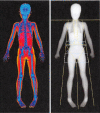Relationship between floating toes condition and lower limb muscle weight in 8-year-old children: the Yamanashi adjunct study of the Japan Environment and Children's Study (JECS-Y)
- PMID: 36866014
- PMCID: PMC9974319
- DOI: 10.1589/jpts.35.252
Relationship between floating toes condition and lower limb muscle weight in 8-year-old children: the Yamanashi adjunct study of the Japan Environment and Children's Study (JECS-Y)
Abstract
[Purpose] Floating toe is a condition in which the toes make insufficient contact with the ground. Weak muscle strength is reportedly one cause of floating toe. However, little evidence exists regarding the relationship between foot muscle strength and floating toe. Here we examined the relationship between foot muscle strength and floating toe by investigating the children' lower extremity muscle mass and floating toe conditions. [Participants and Methods] This cohort study enrolled 118 8-year-old children (62 females, 56 males) with recorded footprints and muscle mass evaluations using dual-energy X-ray absorptiometry. We calculated the floating toe score using the footprint. We measured the muscle weights and the muscle weights divided by the lengths of the lower limbs separately on the left and right sides using dual-energy X-ray absorptiometry. [Results] No significant correlations were observed between the floating toe score and muscle weights or muscle weights divided by lower-limb lengths for either gender or side. [Conclusion] In this study, no significant correlation was found between floating toe degree and lower limb muscle mass, suggesting that lower limb muscle strength is not the primary cause of floating toe, at least in children.
Keywords: Dual-energy X-ray absorptiometry (DEXA); Floating toe; Footprint.
2023©by the Society of Physical Therapy Science. Published by IPEC Inc.
Conflict of interest statement
None.
Figures


Similar articles
-
Prevalence of floating toe and its relationship with static postural stability in children: The Yamanashi adjunct study of the Japan Environment and Children's Study (JECS-Y).PLoS One. 2021 Mar 24;16(3):e0246010. doi: 10.1371/journal.pone.0246010. eCollection 2021. PLoS One. 2021. PMID: 33760833 Free PMC article.
-
A cross-sectional study on the correlations between floating toe, plantar arch posture, and body composition in 8-year-old children.Foot Ankle Surg. 2022 Oct;28(7):1035-1039. doi: 10.1016/j.fas.2022.02.011. Epub 2022 Feb 18. Foot Ankle Surg. 2022. PMID: 35210187
-
Incidence of floating toe and its association with the physique and foot morphology of Japanese children.J Phys Ther Sci. 2015 Oct;27(10):3159-62. doi: 10.1589/jpts.27.3159. Epub 2015 Oct 30. J Phys Ther Sci. 2015. PMID: 26644665 Free PMC article.
-
Relationship between foot alignment and floating toes classified in static and dynamic conditions in females.J Phys Ther Sci. 2019 Mar;31(3):282-286. doi: 10.1589/jpts.31.282. Epub 2019 Mar 19. J Phys Ther Sci. 2019. PMID: 30936646 Free PMC article.
-
Reliability and correlates of cross-sectional area of abductor hallucis and the medial belly of the flexor hallucis brevis measured by ultrasound.J Foot Ankle Res. 2018 Jun 7;11:28. doi: 10.1186/s13047-018-0259-0. eCollection 2018. J Foot Ankle Res. 2018. PMID: 29977344 Free PMC article. Review.
Cited by
-
Advances in the Causes and Treatment of Floating Toes after the Weil Osteotomy: A Scoping Review.Orthop Surg. 2024 Jun;16(6):1257-1268. doi: 10.1111/os.14061. Epub 2024 May 1. Orthop Surg. 2024. PMID: 38693601 Free PMC article.
References
-
- Fukuyama K, Maruyama H: Occurrence of floating toe from the viewpoint of the structure of foot arch. J Phys Ther Sci, 2011, 23: 33–36.
-
- Hofstaetter SG, Hofstaetter JG, Petroutsas JA, et al. : The Weil osteotomy: a seven-year follow-up. J Bone Joint Surg Br, 2005, 87: 1507–1511. - PubMed
-
- Migues A, Slullitel G, Bilbao F, et al. : Floating-toe deformity as a complication of the Weil osteotomy. Foot Ankle Int, 2004, 25: 609–613. - PubMed
-
- Trnka HJ, Nyska M, Parks BG, et al. : Dorsiflexion contracture after the Weil osteotomy: results of cadaver study and three-dimensional analysis. Foot Ankle Int, 2001, 22: 47–50. - PubMed

